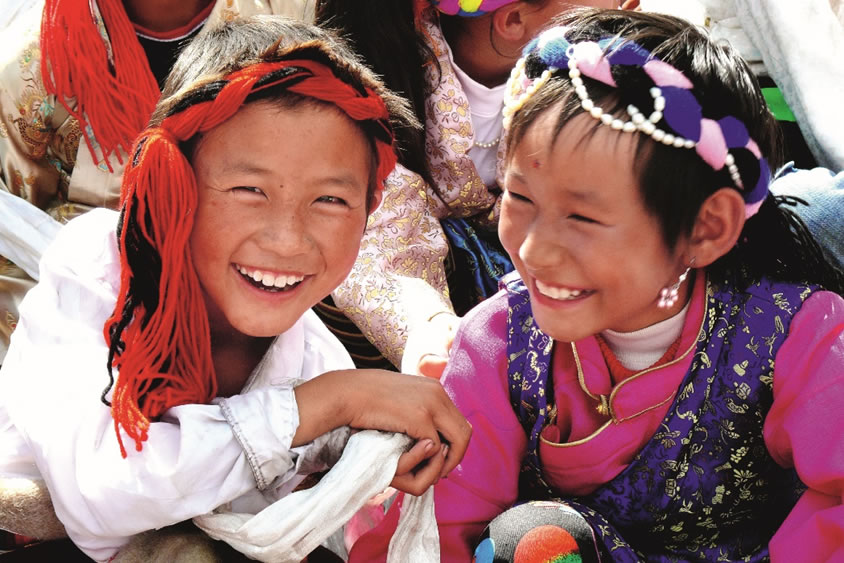Trends
Data snapshot on human rights in Xizang

The State Council Information Office of China released a white paper titled Human Rights in Xizang in the New Era on March 28, highlighted the development and progress of human rights in Xizang since the 18th National Congress of the Communist Party of China (CPC) in November 2012.
The white paper provides an in-depth analysis of the following aspects: whole-process people's democracy; the protection of economic, social and cultural rights; the safeguarding of freedom of religious belief; the guarantee of environmental rights; the protection of the rights of specific groups and the legal protection of human rights.
In today's Trends column, we extract some key indicators from Human Rights in Xizang in the New Era to discuss some issues about Xizang's modernization that may be of interest to you.
1. The whole-process people's democracy
Data 1
Currently, the autonomous region has 26 provincial/ministerial level officials and 512 prefectural/director-general level officials from ethnic minorities. A considerable number of Party and government heads at prefecture and county levels come from ethnic minority groups, and 57.17 percent of the officials in the Party and government leading groups at township level are from ethnic minorities.
Data 2
Since the 18th CPC National Congress in 2012, two elections at the county and township levels have been held in Xizang to elect people's congresses, in which more than 90 percent of eligible voters – 100 percent in some places – in the region participated in these direct elections. Of the 25 deputies of the Xizang delegation to the 14th NPC, 17 or 68 percent are from the Tibetan or other ethnic minority groups, including those with small populations such as the Monba people and the Lhoba people.
Data 3
There are 29 members of the CPPCC National Committee who are residents of Xizang, 93.1 percent of whom are from ethnic minority groups. CPPCC organizations have been established in all 74 county-level administrative units in the region, with more than 8,000 CPPCC members, of whom 85 percent are from ethnic minority groups. Between 2013 and 2024, the CPPCC Committee of the Xizang Autonomous Region received a total of 5,095 proposals, 4,920 were accepted and filed and the rest were given a formal response or reply.
2. The right to an adequate standard of living
Data 1
By the end of 2019, all 628,000 registered impoverished people in the region had risen from poverty. Following this success, the CPC and the Chinese government continued with the rural revitalization strategy to consolidate and expand the achieved outcomes. In 2024, the per capita net income of those lifted out of poverty in Xizang increased by over 12.5 percent.
Data 2
In 2024, the per capita floor space for rural residents stood at 41.32 sq m, 11.74 sq m larger than in 2012.
Data 3
By 2024, the region had 1,359 km of in-service railways, almost double the length in 2012 (701 km), and it had 183 flight routes connecting the region with 78 domestic and international cities. The total road length grew from 65,200 km in 2012 to 124,900 km by the end of 2024. Roads in rural and mountainous areas have seen overall improvement. By the end of 2024, all towns and townships had access to roads.
3. The right to education

Data 1
Since 2012, these subsidies have been raised 11 times, with the figure currently standing at RMB5,620 per student per year, including RMB1,000 from the nutrition improvement program.
Data 2
By 2024, the gross enrollment rate of preschool education reached 91.33 percent, the completion rate of nine-year compulsory education was 97.86 percent, the gross enrollment rate in senior high schools reached 91.56 percent, and the gross enrollment rate of higher education was 57.81 percent. The major educational indicators have reached or exceeded the national average.
4. The right to health
Data 1
According to the Seventh National Census in 2020, the average life expectancy in the region rose from 68.17 years in 2010 to 72.19 years a decade later.
Data 2
By 2024, Xizang had 7,231 medical and health institutions (including 5,222 village clinics), with 21,551 hospital beds and 29,379 healthcare professionals, representing an increase of 29.79 percent, 112.66 percent, and 159.42 percent, respectively, compared with 2012.
5. The protection of cultural rights
Data 1
Xizang now boasts 2,760 ICH items on the representative lists of all types and levels, with 1,668 bearers. Xizang has completed a rescue effort to record the knowledge and skills of 66 old-age bearers of the ICH items on the national representative list and of eight bearers of the ICH items on the regional representative list, and has set up 224 ICH workshops.
Data 2
By December 2024, more than 67,000 folios of rare ancient texts had been uploaded to global cloud-sharing platforms, more than 18,000 rare ancient texts from 1,180 units had been registered and filed, 305 ancient texts had been included in the Catalog of National Rare Books of China, and some 13,990 broken folios of ancient texts had been repaired.
Data 3
By the end of 2024, Xizang was home to 43 museums, exhibition halls, and memorial halls, 82 libraries, 82 people's art halls and cultural centers, 697 all-purpose cultural stations in towns and townships, and over 1,600 cultural squares. Mobile stage trucks and mobile libraries are utilized across 74 counties and equivalent administrative units. A five-tiered network of public cultural service facilities has taken shape throughout the region.
Data 4
By the end of 2024, Xizang had 17 periodicals and 11 newspapers in the Tibetan language and had published 46.85 million copies of 8,794 Tibetan-language books. Every year, more than 15,000 hours of radio programs, more than 80 movies, and 7,300 hours of TV programs are translated or dubbed from and into minority languages.
Data 5
Courses on both standard Chinese and Tibetan are taught in primary and secondary schools in Xizang. In 2023 an online platform to deal with queries concerning the two languages was launched, hosting a database of 300,000 standard terms.
6. The freedom of religious belief
Data 1
The region is home to over 1,700 sites for the practice of Tibetan Buddhism and approximately 46,000 Buddhist monks and nuns. There are four mosques and about 12,000 native Muslims, and one Catholic church with over 700 believers.
Data 2
Nine Tibetan Buddhism colleges, including the High-level Tibetan Buddhism College of China and Xizang Tibetan Buddhist Institute, have been constructed in China with an investment of RMB920 million.
The traditional system whereby Tibetan Buddhist monks learn sutras in monasteries and temples has been integrated with the three-level academic title system of modern education; 130 monks in Xizang have earned the highest Thorampa title, and over 3,000 monks are learning sutras at Xizang Tibetan Buddhist Institute and its 10 branches.
7. Protection of environmental rights

Data 1
Xizang has established 47 nature reserves of all kinds, covering 412,200 sq km. According to the third national territorial land survey, forests, grasslands, wetlands, water bodies and other lands with strong eco-environmental functions reached 1.08 million sq km in Xizang.
Data 2
Since 2016, the annual proportion of days with excellent or good air quality in Xizang has reached over 99 percent. In 2024, Lhasa ranked first among the 168 key cities in China in terms of air quality.
Data 3
A rural greening action saw 10.31 million trees planted across 2,261 administrative villages, while an afforestation project in the mountains to the north and south of Lhasa has led to 10.58 million mu (705,333 ha) of forests being planted and nearly 3.83 million mu (255,333 ha) tended.
8. The rights of specific groups
Data 1
In effect, women represent 36.6 percent of the region's delegates to the 20th CPC National Congress, 28 percent of its deputies to the 14th NPC, and 22.6 percent of its members of the 14th CPPCC National Committee.
Data 2
A project to distribute free nutrition packs to children aged 6-36 months has benefited approximately 160,000 children.
Data 3
There are 11 child welfare institutions in the region. The basic living allowances for orphans and de facto orphans have been improved, providing a maximum of RMB1,982 per person per month.
Data 4
There are 65 day-care centers providing life care, spiritual support, and cultural entertainment for the elderly. Additionally, there are 80 nursing homes for severely disadvantaged people that provide support for seniors who agree to be cared for in nursing homes. By the end of 2024, 5,836 senior citizens were benefitting from care in nursing homes, and 7,135 were provided with home care. By the end of 2024, homes of 2,315 households comprising severely disadvantaged elderly people had undergone age-friendly renovations.
Data 5
Xizang leads the country with more than 95 percent of its people with disabilities having access to basic rehabilitation services and assistive devices.
Data 6
Individuals with disabilities in Xizang are fully covered by social security. Xizang has spent RMB1.1 billion on this initiative, delivering subsidies for more than 500,000 times to eligible persons in the region.
9. The legal protection of human rights
Data 1
By the end of 2024, the People's Congress of the Xizang Autonomous Region and its Standing Committee had enacted and implemented 171 local regulations, and resolutions and decisions with the same legal standing as regulations. Among these, 136 are currently in effect, while 35 have been repealed. These measures ensure that citizens are able to enjoy political, economic, social, cultural and environmental rights in accordance with the law.
Data 2
From January 2016 to December 2024, people's courts at all levels in the region received 1,416 judicial relief cases and concluded 1,397 of them, with a total of RMB28.69 million of judicial aid granted.
Data 3
The region works to open courses on the rule of law which integrates human rights knowledge and covers all the students in various types of schools in the region.
This article is an excerpt from Human Rights in Xizang in the New Era, published by the State Council Information Office of the People's Republic of China.
Kang Mengting, Zhang Weiwei /Editor
The views don't necessarily reflect those of DeepChina.
